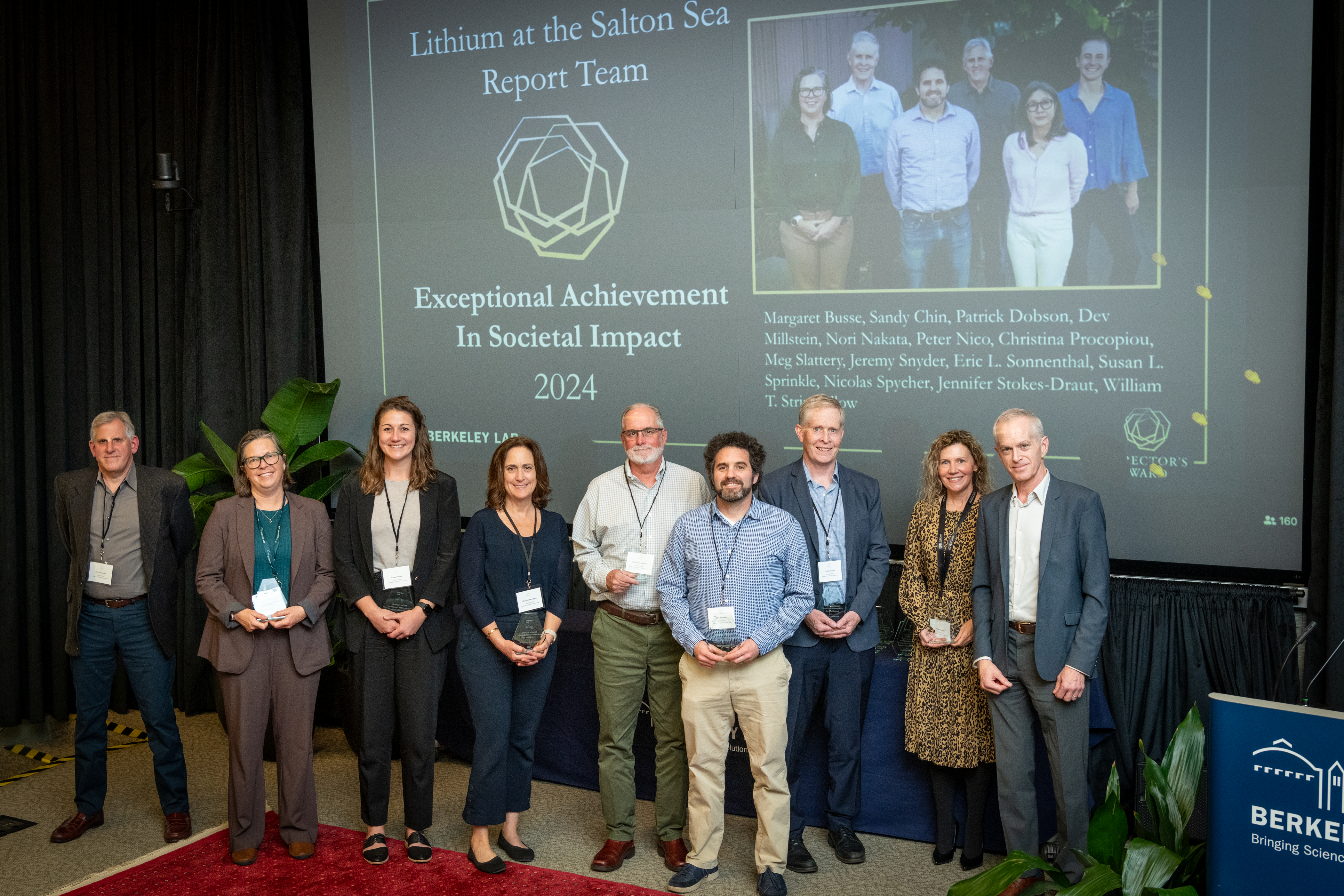Learn why Lawrence Berkeley National Laboratory awarded the team behind a pivotal geothermal lithium resource characterization report for their societal impact.
Geothermal Technologies Office
December 17, 2024
Members of the "Characterizing the Geothermal Lithium Resource at the Salton Sea” report team receive the Directors Award for Societal Impact. Left to Right: Eric Sonnenthal, Jennifer Stokes-Draut, Margaret Busse, Christina Procopiou, Will Stringfellow, Dev Millstein, Patrick Dobson, Susan Sprinkle, and Bill Collins (Associate Lab Director)
Photo Credit: © The Regents of the University of California, Lawrence Berkeley National Laboratory
The Lawrence Berkeley National Laboratory has recognized the team responsible for the “Characterizing the Geothermal Lithium Resource at the Salton Sea” report with the 2024 Director’s Award for Societal Impact. The annual LBNL Director’s Awards program recognizes significant achievements of Lab employees, with the Award for Societal Impact specifically acknowledging outstanding research that furthers solutions to large social problems or pressing societal questions.
In this case, the question is: How can the United States find and extract lithium domestically?
A relatively rare element and critical mineral, lithium is a metal found in rocks and subsurface fluids called brines—including the brines used in geothermal electricity generation. It is the major ingredient in the rechargeable batteries found in phones, hybrid cars, electric bikes, and even large, grid-scale storage batteries. However, a large portion of the lithium currently used in the United States is imported. The Geothermal Technologies Office (GTO) funds efforts like LBNL’s lithium report to help the nation find and access domestic lithium in conjunction with geothermal power production.
The report team helped answer the domestic lithium question by providing the most comprehensive assessment to date of lithium in the Salton Sea geothermal region, one of the largest known lithium deposits in geothermal brines. GTO funded the characterization research and analysis to provide better understanding of that resource and the opportunities and challenges associated with developing it. In addition to quantifying the potential lithium resource, LBNL’s analysis outlines scenarios for optimizing geothermal energy production and sustainable lithium extraction. The analysis concluded that total lithium resources in the region could produce more than 3,400 kilotons of lithium, enough to support over 375 million batteries for electric vehicles.
The team also prioritized community engagement. The Salton Sea region has a history of environmental issues resulting largely from evaporation of the lake, making residents sensitive to research and development in this ecologically important area. While preparing the report, the LBNL team took special care to connect with local communities and understand these concerns by conducting an outreach visit including Q&A sessions with community members in Niland and students at Imperial Valley College. The team developed a Frequently Asked Questions document about the report and its findings, making this highly technical work accessible and engaging for more audiences. The report also creates best practices and provides recommendations on how future research efforts can address community concerns and implement more community-engaged practices.
This award-winning LBNL team has created pathways forward for lithium extraction in the United States and provided a framework to ensure that communities impacted by energy research have a say. To continue this vital work, GTO is funding the laboratory for a second phase of this project, which will include improvements to the models, assessments of other critical minerals present in the region, and expanded community outreach. To learn more about GTO’s research and development around lithium extraction from geothermal brines, visit our website.

